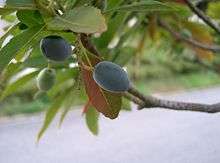Elaeocarpus sylvestris
| Elaeocarpus sylvestris | |
|---|---|
 | |
| Elaeocarpus sylvestris, branch with fruits | |
| Scientific classification | |
| Kingdom: | Plantae |
| (unranked): | Angiosperms |
| (unranked): | Eudicots |
| (unranked): | Rosids |
| Order: | Oxalidales |
| Family: | Elaeocarpaceae |
| Genus: | Elaeocarpus |
| Species: | E. sylvestris |
| Binomial name | |
| Elaeocarpus sylvestris (Lour.) Poir. 1811 | |
| Subspecies | |
| |
| Synonyms | |
| |
Elaeocarpus sylvestris, the woodland elaeocarpus, is a tree species in the genus Elaeocarpus.
Distribution
The woodland elaeocarpus is found in China (Fujian, Guangdong, Guangxi, Guizhou, Hainan, Hunan, Jiangxi, Sichuan, Yunnan, Zhejiang), Japan, Korea, Taiwan and Vietnam (Indochina).
Vernacular names
- Chinese: 山杜英 shan du ying
- Japanese: ホルトノキ Horutonoki or モガシ Mogashi
- Korean: 담팔수 dampalsu
- Vietnamese : Côm trâu, Côm cánh trụi, côm rừng, côm gạo, côm lá to, côm tầng, xương cá[1]
Description
The tree is up to 15 m and is found in evergreen forests at altitudes comprised between 300 and 2000 m. The evergreen shiny leaves are oblanceolate. The greeny-white flowers are grouped in racemes and are followed by black olive-like fruit in autumn.
Uses
The fruits of the woodland elaeocarpus are edible. The oil from the seeds may be processed into soap or lubricants. The bark may be used as a source for dye. The wood does not resist water, so it is not considered good timber, but it is used for growing shiitake mushrooms.[2]
It is also planted along streets and in parks.
Ecology
The larvae of the moth Leucoblepsis excisa feed on the leaves of E. sylvestris. In urban forests of Kamakura, Kanagawa, Japan, the Formosan squirrel (Callosciurus erythraeus taiwanensis) is a pest to the tree because of its gnawing habit.[3]
Woodland elaeocarpus in susceptible to Elaeocarpus yellows, a disease discovered in 1999[4][5] and a type of Phytoplasma disease, which causes a chlorosis (Japanese: 萎黄病 io-byo)[6] of the plant.[7] Oxytetracycline has been used to fight the pathogen.[5][7]
Chemistry
This species contains the gallotannin 1,2,3,4,6-penta-O-galloyl-beta-D-glucose, a compound that may be used in radioprotection.[8] It also contains elaeocarpusin, a molecule with a unique acid ester group probably derived by a condensation of a hexahydroxydiphenoyl group and dehydroascorbic acid attached to the 2,4-positions of 1-O-galloyl- 3,6-(R)-hexahydroxydiphenoyl-D-glucopyranose (corilagin).[9]
Symbolism
The horutonoki (Elaeocarpus sylvestris var. ellipticus) is the tree symbol of Japanese city Urasoe, Okinawa. Wild Dampalsu trees (Elaeocarpus sylvestris var. ellipticus) in Cheonjiyeon Waterfall are South Korean Natural Monument no. 163.[10]
Picture gallery
 var. ellipticus
var. ellipticus var. ellipticus
var. ellipticus var. ellipticus
var. ellipticus var. ellipticus
var. ellipticus var. ellipticus
var. ellipticus var. ellipticus
var. ellipticus var. ellipticus
var. ellipticus var. ellipticus
var. ellipticus- var. ellipticus.
- var. ellipticus. Hampyung, Korea
.jpg) This big Elaeocarpus sylvestris tree is located in Hihayo Tenjin Shrine, Ito city, Shizuoka Prefecture, Japan. It's Japan biggest Elaeocarpus sylvestris.
This big Elaeocarpus sylvestris tree is located in Hihayo Tenjin Shrine, Ito city, Shizuoka Prefecture, Japan. It's Japan biggest Elaeocarpus sylvestris.
See also
- Liothrips horutonoki, a thrips species in the genus Liothrips
References
- ↑ Elaeocarpus sylvestris at botanyvn.com
- ↑ Woodland elaeocarpus at taipei-expopark.tw
- ↑ Line census and gnawing damage of introduced Formosan squirrels (Callosciurus erythraeus taiwanensis) in urban forests of Kamakura, Kanagawa, Japan. Masato Hori, Masao Yamada and Noriyuki Tsunoda, in Koike, F., Clout, M.N., Kawamichi, M., De Poorter, M. and Iwatsuki, K. (eds), Assessment and Control of Biological Invasion Risks. Shoukadoh Book Sellers, Kyoto, Japan and IUCN, Gland, Switzerland, 2006, pages 204-209 (article)
- ↑ Elaeocarpus Yellows,a New Disease of Elaeocarpus sylvestris vat.ellipticus Caused by Phymplasma in Japan. Kawabe Y, Kusunoki M and Oono K, Annals of the Phytopathological Soeiely of Japan, 1999
- 1 2 Determination of Oxytetracycline in Elaeocarpus sylvestris var. ellipticus Leaf by High Performance Liquid Chromatography. J. Tsuda, Journal of the Japanese Forest Society, 2006, volume 88, No. 1, pages 46-49, doi:10.4005/jjfs.88.46
- ↑ Elaeocarpus yellows at gene.affrc.go.jp
- 1 2 Analysis of oxytetracycline and detection of phytoplasma after the trunk injection of oxytetracycline formulation in Elaeocarpus sylvestris var. ellipticus infected with elaeocarpus yellows. Kawabe Yuji, Tsuda Jyoei, Matsuura Kuniaki, Ogawa Seiji, Usami Yoichi and Kusunoki Manabu, Journal of tree health, 31-O7-2011, volume 15, issue 3, pages 97-101, (abstract in Japanese)
- ↑ Elaeocarpus sylvestris modulates gamma-ray-induced immunosuppression in mice: implications in radioprotection. Park E, Lee NH, Baik JS and Jee Y, Phytother Res., August 2008, volume 22, issue 8, pages 1046-1051, doi:10.1002/ptr.2430, PMID 18570220
- ↑ Tannins and related compounds. Part 37. Isolation and structure elucidation of elaeocarpusin, a novel ellagitannin from Elaeocarpus sylvestris var. Ellipticus. Takashi Tanaka, Gen-ichiro Nonaka, Itsuo Nishioka, Kazumoto Miyahara and Toshio Kawasaki, J. Chem. Soc., Perkin Trans. 1, 1986, pages 369-376, doi:10.1039/P19860000369
- ↑ english.visitkorea.or.kr
External links
| Wikimedia Commons has media related to Elaeocarpus sylvestris. |
- Elaeocarpus sylvestris at the Encyclopedia of Life
- Elaeocarpus sylvestris at efloras.org
- Elaeocarpus sylvestris at tropicos.org
- Elaeocarpus sylvestris at en.hortipedia.com